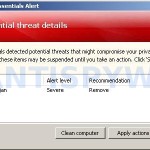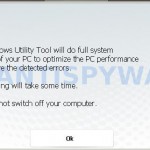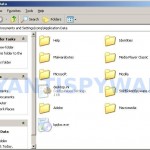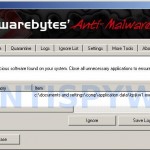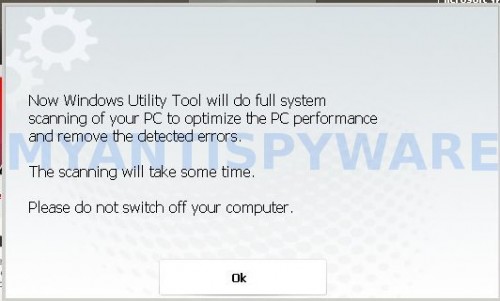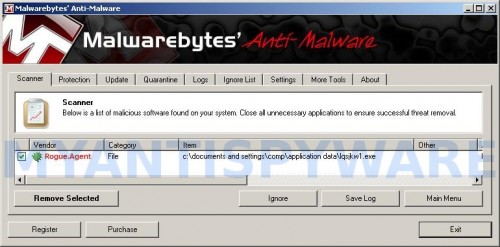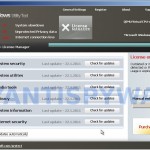 Windows Utility Tool is a rogue (fake) antivirus program that is distributed through the use of Microsoft Security Essentials Alert trojan. This malware displays false information that states “Unknown Win32/Trojan was detected on your computer” and then will suggest you to perform a scan of your PC. It will reports that a program is infected with Trojan.Horse.Win32.PAV.64.a. Remember, the fake antivirus is unable to detect or rid your system of parasites nor will be protect you from legitimate future threats. You need to remove Windows Utility Tool from your computer as quickly as possible!
Windows Utility Tool is a rogue (fake) antivirus program that is distributed through the use of Microsoft Security Essentials Alert trojan. This malware displays false information that states “Unknown Win32/Trojan was detected on your computer” and then will suggest you to perform a scan of your PC. It will reports that a program is infected with Trojan.Horse.Win32.PAV.64.a. Remember, the fake antivirus is unable to detect or rid your system of parasites nor will be protect you from legitimate future threats. You need to remove Windows Utility Tool from your computer as quickly as possible!
During installation, this malware configures itself to start automatically every time, when your computer loads. Once the installation is complete, it will reboot your computer. When Windows is loaded, you will be shown the Windows Utility Tool prompt instead of Windows desktop. But there is no any choice, only “OK” button is active. After click to it, Windows Utility Tool starts scanning your computer and list a lot of infections to trick you into thinking your PC in danger. It will report that was able to clean the majority of infected files, but was not able to cure a few important Windows files and offer to purchase its full version to clean them. However, the scan results is a scam, because the program can`t detect any infections. So, do not pay for the bogus software, simply ignore all that Windows Utility Tool will display you.
As you can see, Windows Utility Tool is a totally scam that hides your desktop, displays false information and detects fake infections. The program created with one purpose to trick you into purchasing so-called “full” version of the program. Please use the removal guide below in order to remove Windows Utility Tool and any associated malware from your computer for free.
Screen shoots of Windows Utility Tool
Use the following instructions to remove Windows Utility Tool
Step 1. Stop Windows Utility Tool from “autorunning”
Once Windows loaded you will see a window similar to the one below.
Click OK button to allow Windows Utility Tool to perform a fake scan. Once scan is complete, it will state you need to open the License Manager. Press the OK, Open the license manager button. Now you can close the program. Click “X” button at the top-right of Windows Utility Tool or press ALT + F4. After that your Windows Desktop will be available.
Click Start, Type in search field (if you use Windows XP, then Click Start, Run and type in Open field):
%APPDATA%
Press Enter. It will open the contents of Application Data folder (for Windows XP) or the contents of Roaming folder (for Windows Vista, Windows 7) as shown in the screen below.
Locate randomly named file (e.g. lqsjkw.exe or lqcjkw, look the example above), right click to it and select Rename. Type any new name (123.exe) and press Enter. Reboot your computer.
Step 3. Remove Windows Utility Tool associated malware
Download MalwareBytes Anti-malware (MBAM). Close all programs and Windows on your computer.
Double Click mbam-setup.exe to install the application. When the installation begins, keep following the prompts in order to continue with the installation process. Do not make any changes to default settings and when the program has finished installing, make sure a checkmark is placed next to Update Malwarebytes’ Anti-Malware and Launch Malwarebytes’ Anti-Malware, then click Finish.
If an update is found, it will download and install the latest version.
Once the program has loaded you will see window similar to the one below.
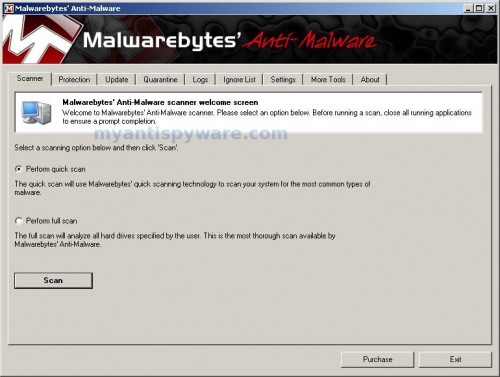
Malwarebytes Anti-Malware Window
Select Perform Quick Scan, then click Scan, it will start scanning your computer for Windows Utility Tool infection. This procedure can take some time, so please be patient.
When the scan is complete, click OK, then Show Results to view the results. You will see a list of infected items similar as shown below. Note: list of infected items may be different than what is shown in the image below.
Make sure all entries have a checkmark at their far left and click “Remove Selected” button to remove Windows Utility Tool. MalwareBytes Anti-malware will now remove all of associated Windows Utility Tool files and registry keys and add them to the programs’ quarantine. When MalwareBytes Anti-malware has finished removing the infection, a log will open in Notepad and you may be prompted to Restart.
Windows Utility Tool removal notes
Note 1: if you can not download, install, run or update Malwarebytes Anti-malware, then follow the steps: Malwarebytes won`t install, run or update – How to fix it.
Note 2: if you need help with the instructions, then post your questions in our Spyware Removal forum.
Note 3: your current antispyware and antivirus software let the infection through ? Then you may want to consider purchasing the FULL version of MalwareBytes Anti-malware to protect your computer in the future.
Windows Utility Tool creates the following files and folders
%AppData%\{RANDOM}.exe
Windows Utility Tool creates the following registry keys and values
HKEY_CURRENT_USER\Software\Microsoft\Windows NT\CurrentVersion\Winlogon | Shell = “%AppData%\{random}.exe”
